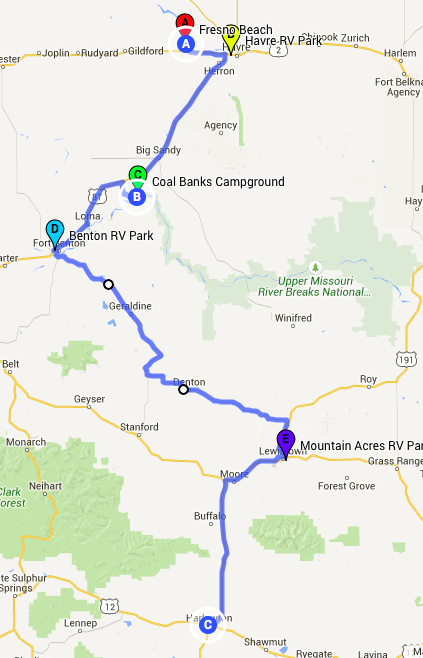Oh, yes, I had a very scientific approach when I finally sat down with a map to determine what my route would look like these first few months; where would I go and how would I move around the 70,000 square miles I plan on visiting? It was based mostly on recognition: of town and river names, of places I’ve read of or heard about, of the settings for stories, of books, that were written of the West and of wandering souls. I chose places with names that evoked memories of places I’d never been.
Musselshell, Marias, and Milk rivers; Judith Gap, Round Up, and Havre; a curiosity without expectations. If the open grasslands between Roswell and Clines Corner, New Mexico, stirred my fledgling ambition to live in all that space; and the hills, shapes, colors of landscapes everywhere ignited a affinity for art and geology, it is a good thing that seeing Montana at the pace and deliberateness that I have been doing occurred this late in my life. All this wide-open vastness and continuously changing geomorphology would have zapped my mind—to say nothing of the allure of names of places that take me back to times that I haven’t even experienced. I am smitten by this state.
I have been moving north pretty much along the 110th meridian. If you look at a map of central Montana much of the public land to the East is Bureau of Land Management and to the West is Forest Service, with a huge section that is neither-remote lands that are home to farms of thousands of acres, towns that have populations of less than 5,000, or even 1,000, that are vibrant, enduring , genial—and down-to-earth.
A website for things to do in Lewistown (population just under 6,000) listed under “Nightlife:” two bars, a coffee club, the American Legion, and a church.
It seems that so much of this country is pushing for more: for something bigger, fancier, newer, or more exciting. I am beginning to feel that what we need, what is better, exists in places like these small communities in Montana—and probably in Iowa, New Mexico, or even Arkansas. How refreshing to be in places that are OK with their history, their pace, their acceptance of stability and consistency. But then maybe the folks living in these towns are pulsing with dissatisfaction and just want to live in a place like Jackson Hole or New York City.
Week #3 Species I Have Seen
Twice this past week I was parked at BLM campgrounds; one at a Missouri River boat launch site beside a windbreak that was long, 10 feet wide, and very thick; another where two small, marshy ravines flowed into the Milk River. They provided an amazing number of species to watch. This is where I saw 8-10 goldfinch, a gazillion robins, heard the pheasant, saw grey partridge, western wood pee-wee, western king bird, and watched the brown thrasher. I am also pretty sure that I saw an american bittern, I only saw it once landing and another time flying, but the size, behavior and habitat were all right-on.
- Kestrel
- Goldfinch
- Mountain Bluebird
- Pheasant–heard all afternoon right beside me, but didn’t see
- White Pelicans
- Common Merganser
- Mallard
- Brown Thrasher–just happened to have my Sibley’s book in my lap as I watched this bird, 30 feet away from me, feed very warily for about 10 minutes.
- Pronghorn
- Killdeer
- Meadowlark
- Robins–lots of them!
- Western wood -pewee
- Western kingbird
- Gray partridge
- Franklin’s gull
- Yellow warbler
- Mourning dove
- Harris’s hawk
- Cottontails–even more than robins




